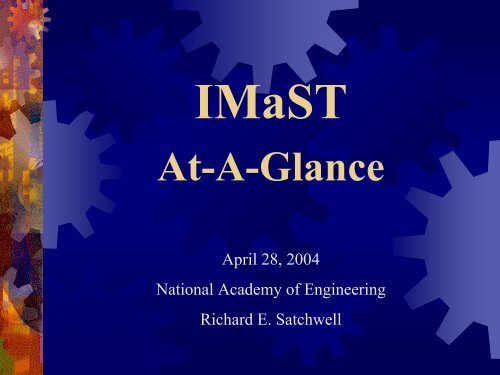Integrated Mathematics, Science, and Technology - National ...
Integrated Mathematics, Science, and Technology - National ...
Integrated Mathematics, Science, and Technology - National ...
Create successful ePaper yourself
Turn your PDF publications into a flip-book with our unique Google optimized e-Paper software.
IMaST<br />
At-A-Glance<br />
April 28, 2004<br />
<strong>National</strong> Academy of Engineering<br />
Richard E. Satchwell
Introductions<br />
Your name<br />
What state you’re from<br />
Which discipline
Today’s Challenge<br />
Look for things that<br />
separate IMaST from<br />
other curricula
What is IMaST<br />
An <strong>Integrated</strong> <strong>Mathematics</strong>, <strong>Science</strong> &<br />
<strong>Technology</strong> curriculum for middle school<br />
Developed by the Center for <strong>Mathematics</strong>,<br />
<strong>Science</strong> & <strong>Technology</strong> (CeMaST) at<br />
Illinois State University<br />
Funded by the <strong>National</strong> <strong>Science</strong><br />
Foundation
Curriculum Module Titles<br />
6 th Grade<br />
Tools for Learning<br />
Patterns of Mobility<br />
Patterns Within Us<br />
Patterns Around Us<br />
Patterns of Weather<br />
Patterns Above Us<br />
Patterns Below Us<br />
7 th Grade<br />
The Body Works<br />
Shaping Our<br />
World<br />
Living on the Edge<br />
Manufacturing<br />
Forecasting<br />
8 th Grade<br />
Animal Habitats<br />
Human<br />
Settlements<br />
Systems<br />
Communication<br />
Pathways
The IMaST program:<br />
Integrates concepts <strong>and</strong> skills of <strong>Mathematics</strong>,<br />
<strong>Science</strong>, <strong>and</strong> <strong>Technology</strong><br />
Uses a constructivist approach to teaching &<br />
learning<br />
Promotes teamwork among teachers from<br />
different disciplines<br />
Utilizes authentic, relevant methods of<br />
assessment
The IMaST program:<br />
Encourages student group work<br />
Meets benchmarks for national st<strong>and</strong>ards in<br />
<strong>Mathematics</strong>, <strong>Science</strong> <strong>and</strong> <strong>Technology</strong><br />
Relates to disciplines beyond M/S/T<br />
Responds to the latest research in<br />
teaching/learning <strong>and</strong> cognitive science
Today’s Activity<br />
The Body Works<br />
Go to learning cycle 4 titled “Circulating<br />
Blood” on page 79<br />
Find a partner <strong>and</strong> begin reading the<br />
Introduction<br />
Follow the directions in the book<br />
You may have to share some of the tools
What Makes IMaST Different<br />
IMaST activities address real world<br />
problems<br />
Students are encouraged to explore, make<br />
predictions, <strong>and</strong> create solutions while<br />
applying their knowledge <strong>and</strong> skills to<br />
various challenges
IMaST Modules<br />
Teach big ideas in global contexts<br />
Go beyond <strong>Mathematics</strong>, <strong>Science</strong>, &<br />
<strong>Technology</strong><br />
Relate to the real world<br />
Promote problem solving – DAPIC<br />
• Promote critical thinking skills<br />
• Contain experience-based learning activities<br />
• Facilitate individual <strong>and</strong> team growth<br />
• Develop student underst<strong>and</strong>ing
Why Use IMaST<br />
It raises the st<strong>and</strong>ard of teaching <strong>and</strong> learning by:<br />
Providing an integrated curriculum<br />
Promoting h<strong>and</strong>s-on learning for students<br />
Promoting teamwork among teachers from<br />
different disciplines
Investigation &<br />
Reflection<br />
Look at the IMaST modules<br />
What is the purpose of the Challenge<br />
Why are there several “key concepts”<br />
What are the stages in the IMaST<br />
learning cycle<br />
What is the purpose of the “Making<br />
Connections” readings
Reflection continued<br />
Why are there “Career Connections”<br />
readings<br />
What is role of the teacher in IMaST<br />
What is the role of the student<br />
How is problem solving taught
DAPIC
Professional Development<br />
Workshop for teachers <strong>and</strong><br />
administrators<br />
Introduction to IMaST<br />
Teach several learning cycles<br />
Learn new skills (tools, techniques,<br />
class room management, etc.<br />
Learn new content<br />
Learn to plan <strong>and</strong> work together
Results (6 th Grade)<br />
TerraNova mathematics <strong>and</strong> science subtests<br />
Used to check knowledge gain in 6 th grade<br />
<strong>Mathematics</strong>—IMaST gained more, but not<br />
statistically significant<br />
<strong>Science</strong>—IMaST gained more <strong>and</strong> it was<br />
statistically significant
Results (7 th Grade)<br />
Stanford Achievement Test was used<br />
for the 7 th grade to make sure students<br />
kept pace with control group<br />
Qualitative data indicated that students<br />
were much better at problem solving<br />
<strong>and</strong> they naturally made connections<br />
among the disciplines
Results (8 th Grade)<br />
TIMSS was used for the 8 th grade<br />
Students in IMaST scored higher than<br />
control group <strong>and</strong> the predicted USA<br />
level in mathematics<br />
Students scored higher at a statistically<br />
significant level in science
Overall results<br />
Have yet to test students that have<br />
been in three years of IMaST—need<br />
more research<br />
Related developments<br />
IMaST students become better<br />
communicators—both oral <strong>and</strong> written<br />
IMaST students do well on st<strong>and</strong>ardized<br />
tests even though IMaST is not designed<br />
to help in this area
Results continued<br />
Teachers learn new content<br />
Teachers learn new pedagogy<br />
Teachers learn to work together<br />
Students make connections<br />
Students relate mathematics to real<br />
world!
IMaST is idealistic but<br />
The results are worth the extra effort!<br />
<strong>Technology</strong> education is on par with<br />
mathematics <strong>and</strong> science!<br />
<strong>Technology</strong> education has a big<br />
influence on the learning cycles in math<br />
<strong>and</strong> science!<br />
And students LEARN to LEARN!
For more IMaST Details<br />
IMaST Website<br />
http://www.ilstu.edu/depts/cemast/imast/imasthome.htm<br />
Center for Math, <strong>Science</strong> & <strong>Technology</strong><br />
Phone: (309) 438-3089<br />
Fax: (309) 438-3592<br />
Address: 207 South Main, MC 5960<br />
Illinois State University<br />
Normal, Illinois 61790-5960
For publishing<br />
information:<br />
RonJon Publishing, Inc.<br />
Phone: (800) 262-3060<br />
Fax: (940) 387-0505<br />
1001 South Mayhill Rd.<br />
Denton, TX 76208<br />
http:\\www.ronjonpublishing.com


